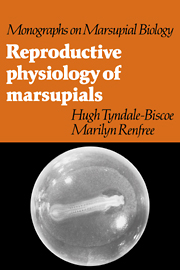Book contents
- Frontmatter
- Contents
- Preface
- 1 Historical introduction
- 2 Breeding biology of marsupials by family
- 3 Sexual differentiation and development
- 4 Male anatomy and spermatogenesis
- 5 The female urogenital tract and oogenesis
- 6 Ovarian function and control
- 7 Pregnancy and parturition
- 8 Lactation
- 9 Neuroendocrine control of seasonal breeding
- 10 Marsupials and the evolution of mammalian reproduction
- References
- Index
9 - Neuroendocrine control of seasonal breeding
Published online by Cambridge University Press: 06 January 2010
- Frontmatter
- Contents
- Preface
- 1 Historical introduction
- 2 Breeding biology of marsupials by family
- 3 Sexual differentiation and development
- 4 Male anatomy and spermatogenesis
- 5 The female urogenital tract and oogenesis
- 6 Ovarian function and control
- 7 Pregnancy and parturition
- 8 Lactation
- 9 Neuroendocrine control of seasonal breeding
- 10 Marsupials and the evolution of mammalian reproduction
- References
- Index
Summary
Most species of marsupial are seasonal breeders and, as shown in Chapter 2, the emergence of the young at the end of lactation coincides with the most favourable season of the year. For small species with a short gestation and pouch life (Russell, 1982a) the environmental factor that determines the mating season may be some component of favourable conditions such as increasing temperature or protein rich food (e.g. in the Peramelidae, see p. 53) although photoperiod may be an additional factor (e.g. in Sminthopsis crassicaudata (Godfrey, 1969b), see p. 41). For larger species with a longer pouch life, however, mating may occur at a time when environmental conditions are highly unfavourable (e.g. in Setonix brachyurus, see p. 85) and, for these species, photoperiod may be an important factor. By far the best-studied marsupial in this regard is Macropus eugenii and in this chapter we will discuss the evidence for control of seasonal breeding by daylength in this species.
The highly seasonal nature of breeding in M. eugenii was described in Chapter 2 (Fig. 2.26) and other aspects of the interrelationship between the corpus luteum, ovary and blastocyst were referred to in Chapters 6 and 7 respectively. Superficially the reproductive pattern resembles that of the domestic sheep in that both species mate during declining photoperiod; for that reason they are said to be ‘short-day’ breeders. During the period of increasing daylength the ewe is anoestrous (Legan, Karsch & Foster, 1977) and the ram has small testes in which spermatogenesis is much reduced or absent (Lincoln & Short, 1980).
- Type
- Chapter
- Information
- Reproductive Physiology of Marsupials , pp. 373 - 395Publisher: Cambridge University PressPrint publication year: 1987



